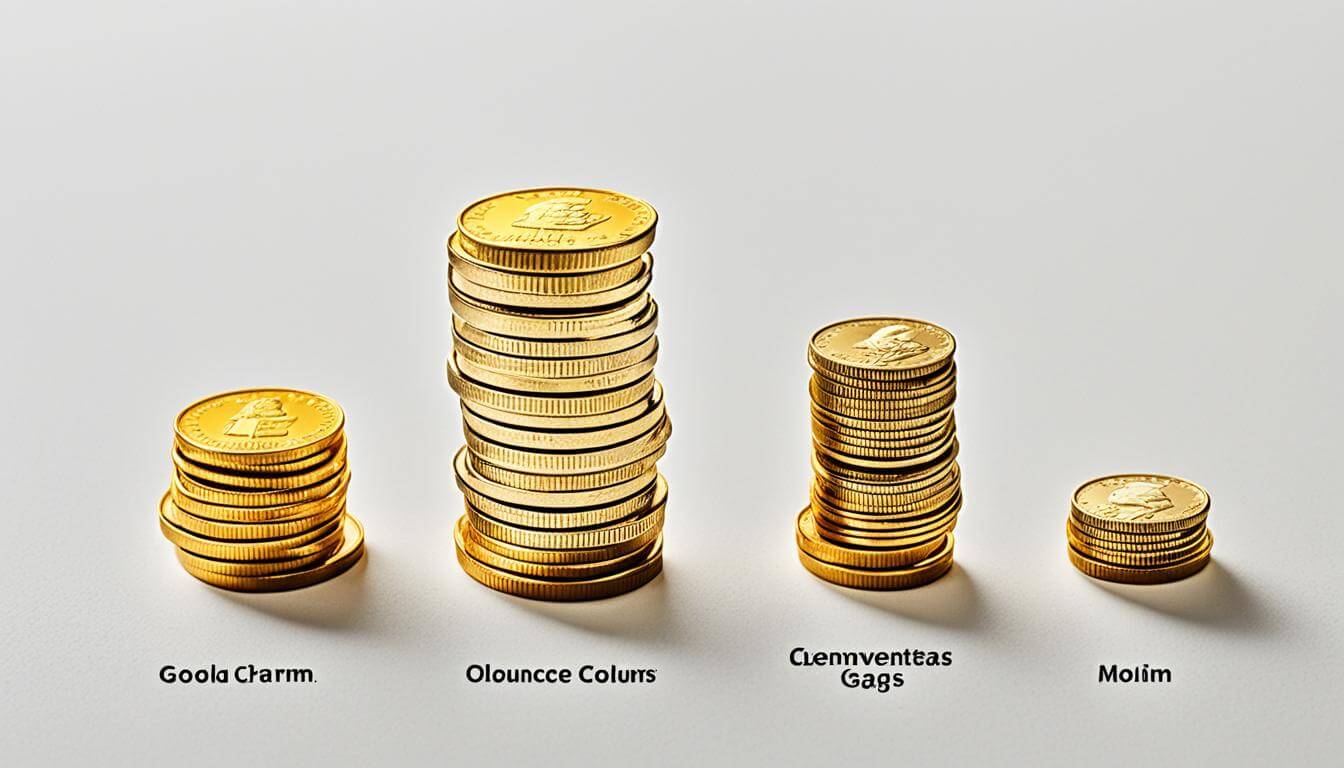When it comes to understanding the weight of gold, it’s crucial to be familiar with the conversion between ounces and grams. Gold, being a precious metal, is typically measured in troy ounces, which differ from standard ounces used for everyday objects. So how many ounces are in a gram of gold? Let’s dive into the world of gold conversion to unveil the answer.
A troy ounce, commonly used in the precious metals market, is equivalent to 31.1034768 grams. This unit of measure, based on the troy weight system that dates back to the Middle Ages, provides a standardized way to weigh gold accurately.
The troy ounce serves as the reference point for pricing precious metals like gold, platinum, and silver. It allows for consistency in the valuation of these metals and is also utilized in the weighing of certain gemstones.
It’s important to differentiate between a troy ounce and a regular ounce, also known as an avoirdupois ounce. While a regular ounce is used for common commodities like sugar and grain, a troy ounce is specifically designed for weighing precious metals. In fact, one troy ounce equals 1.097 regular ounces, making it slightly heavier.
Converting troy ounces to other common weights is an essential skill for anyone involved in the gold industry. For instance, one troy ounce equals 0.0311 kilograms or 480 grains. Understanding these conversion factors is critical for accurate pricing, measurements, and calculations.
Now that you have a grasp on gold conversion and the relationship between ounces and grams, you’ll be better equipped to navigate the world of precious metals. Whether you’re an investor or a jeweler, knowing the ounces in a gram of gold is an invaluable tool.
Understanding The Troy Ounce
The troy ounce is the standard unit of measurement for pricing precious metals, including gold, platinum, and silver. It plays a crucial role in the precious metals market, where prices are often listed per-ounce. This measurement is not limited to metals alone, as the troy ounce is also used in the weighing of certain gemstones.
The origin of the troy weight system, in which the troy ounce is defined, can be traced back to the Middle Ages. It is believed to have originated in the historic French city of Troyes, hence the name “troy” ounce. Over the years, it has gained international recognition as the standard unit of measure for precious metals.
- Pricing: The troy ounce is commonly used in the pricing of precious metals and serves as a reference point for determining their value in the market.
- International Adoption: The troy ounce has been adopted worldwide as a standard unit of measurement for precious metals, ensuring a consistent valuation.
- Historical Significance: The troy weight system has a rich history that spans centuries, making it an enduring method of measuring precious metals.
- Wide Application: Not only is the troy ounce used in the pricing of precious metals, but it is also relied upon in the jewelry industry and the weighing of certain gemstones.
By understanding the significance of the troy ounce, investors and stakeholders in the precious metals industry can confidently navigate the dynamics of precious metal pricing and ensure accurate assessments of their investments.
Troy Ounce Vs. Ounce
When it comes to weight measurement, it is crucial to understand the difference between a troy ounce and a regular ounce, also known as an avoirdupois ounce.
A regular ounce is commonly used to measure commodities like sugar and grain, while a troy ounce is specifically used for weighing precious metals such as gold.
The troy ounce is slightly heavier than a regular ounce, with one troy ounce equaling 1.097 regular ounces. This distinction may seem small, but in the world of gold trading, even slight variations in weight can have a significant impact on the price.
Why Is The Difference Important?
The discrepancy between a troy ounce and a regular ounce is relevant in the context of gold trading. Precious metals are often traded and priced using troy ounces, so understanding the specific weight measurement is crucial for accurate valuation and transactions.
For example, if you are buying or selling gold, knowing that one troy ounce is slightly heavier than one regular ounce ensures that you are obtaining the correct weight and value. This knowledge is particularly crucial in the gold market, where pricing is based on the troy weight system.
The Impact On Pricing
The weight difference between a troy ounce and a regular ounce can have a noticeable impact on pricing. Even small variations in weight can lead to significant differences in the overall value of precious metals. It is essential for professionals in the precious metals industry, such as jewelers, traders, and investors, to accurately measure and calculate the weight of gold using the appropriate unit of measurement.
With this understanding, you can navigate the gold market with confidence, knowing the distinction between a troy ounce and a regular ounce and its implications in pricing.
- A troy ounce is specifically used for weighing gold and other precious metals
- A regular ounce is commonly used for commodities like sugar and grain
- One troy ounce is slightly heavier than one regular ounce, with a ratio of 1:1.097
- Even small variations in weight can impact the price of gold in the market
Understanding the difference between a troy ounce and a regular ounce is essential for anyone involved in the gold industry. Whether you are a jeweler, trader, or investor, it ensures accurate valuations and transactions, ensuring you have the correct weight and value of precious metals.
Troy Ounce Conversion
Converting troy ounces to other common weights can be useful in various scenarios. When it comes to converting a troy ounce to grams, a conversion factor of 31.1035 is used. This means that one troy ounce is equivalent to 31.1035 grams. Grams are a widely used unit of measurement in many parts of the world, making this conversion factor quite valuable.
For those who prefer to work with pounds, the conversion from troy ounces to pounds is as follows: one troy ounce is equal to 0.0685 pounds. Though pounds are primarily used to measure weight in the United States, understanding this conversion can be beneficial for international transactions and comparisons.
If you are more accustomed to metric measurement, you may find it helpful to convert troy ounces to kilograms. One troy ounce is equivalent to 0.0311 kilograms. This conversion can be particularly useful when dealing with gold as a commodity in countries where the metric system is the standard unit of measurement.
In addition to grams, pounds, and kilograms, there are other units commonly used when working with precious metals. For example, converting troy ounces to grains yields a value of 480 grains. Grains are commonly used to measure small quantities of gold, making this conversion factor relevant in specific scenarios.
Another unit used in the precious metals industry is the pennyweight. Converting troy ounces to pennyweights results in a value of 20 pennyweights. Similar to grains, pennyweights are often used to measure small quantities of gold or other precious metals.
If you are dealing with gemstones, it’s essential to understand the conversion from troy ounces to carats. One troy ounce is equivalent to 155.517 carats. Carats are a unit of weight commonly used in the gemstone industry.
Understanding these conversion factors allows you to work with troy ounces in a variety of weight measurements, depending on your needs and preferences. Whether you are comparing prices, making calculations, or simply trying to understand the weight of gold in different units, these conversions are valuable tools.
Troy Ounce Conversion
| Troy Ounce | Grams | Pounds | Kilograms | Grains | Pennyweights | Carats |
|---|---|---|---|---|---|---|
| 1 | 31.1035 | 0.0685 | 0.0311 | 480 | 20 | 155.517 |
These conversion factors are essential for understanding the weight of gold in different units and can be valuable when comparing prices or making calculations.
Investing In Precious Metals
Investing in precious metals, such as gold, platinum, and silver, can offer a promising opportunity for financial growth. These metals are highly valued for their rarity and industrial applications, making them attractive assets for investors.
One popular avenue for investing in precious metals is through commodity exchange-traded funds (ETFs) or mutual funds. These funds enable investors to purchase shares that represent a specific amount of precious metals, typically measured in troy ounces. By investing in these funds, individuals can gain exposure to the precious metals market without the hassle of acquiring and storing physical metals themselves.
Another option for investing in precious metals is through common stock shares of companies in the metals and mining sector. Investing in reputable companies involved in the extraction, processing, and distribution of gold, platinum, and silver can provide potential returns as the demand for these metals grows.
It is important to note that the futures and options markets also offer opportunities for trading precious metals. However, these markets are primarily dominated by professionals and institutional investors due to their complexity and risk.

Ultimately, investing in precious metals can be a strategic way to diversify one’s investment portfolio and hedge against economic uncertainties. The value of precious metals, especially gold, has historically shown resilience during times of market volatility. By carefully considering the risks and potential rewards, investors can make informed decisions to capitalize on the enduring value of these sought-after commodities.
Gold Measurements And Purity
When it comes to measuring gold, two essential factors to consider are its weight and purity. Gold is commonly measured using different units, including grams and troy ounces. The purity of gold is expressed in karats, with 24 karat gold being the purest form.
Gold measurements:
- Grams: Grams are commonly used to measure the weight of gold. The weight of gold in grams is crucial when calculating its value and determining the quantity needed for various transactions.
- Troy ounces: Troy ounces are the standard unit of measurement for precious metals, including gold. One troy ounce is equivalent to 31.1035 grams.
Purity:
The purity of gold refers to the amount of pure gold in a piece of jewelry or bullion. It is expressed in karats, with 24 karat gold being 99.9% pure. Lower karat gold contains a higher percentage of other metals, making it less pure.
Millesimal fineness:
Another method of measuring gold purity is through millesimal fineness, which represents the purity in parts per thousand. For example, 750 millesimal fineness means that the gold is 75% pure. This measurement is often used in Europe.
Understanding the measurements of gold is crucial when buying or selling this precious metal. It allows you to assess its value accurately and determine the quality of the gold you are dealing with.
Gold Measurements Across The Globe
While the troy ounce is the standard unit of measurement for gold, different regions around the world may use alternative measurements. It’s important to be aware of these regional variations when trading or purchasing gold internationally.
Golds Measurements In Southeast Asia
In Southeast Asia, the tola is a commonly used unit of measurement for gold. One tola is approximately 11.6638 grams or 0.375 troy ounces. This measurement is prevalent in countries like India, Pakistan, and Bangladesh.
Golds Measurements In China
In China, the preferred unit of measurement for gold is the tael or tahil. One tael is equivalent to approximately 50 grams or 1.6075 troy ounces. The tael has a historical significance in Chinese culture and is still used today for measuring gold.
Golds Measurements In Thailand
In Thailand, the baht is the preferred unit of measurement for gold. One baht is equal to approximately 15.2442 grams or 0.4901 troy ounces. The baht is widely used in the Thai gold market and is an important measurement for gold traders and consumers.
Golds Measurements In Smaller Quantities
For smaller quantities of gold, alternative measurements such as grains and pennyweights are used. A grain is a unit of weight equal to approximately 0.0648 grams or 0.0021 troy ounces. A pennyweight is slightly larger, equivalent to approximately 1.5552 grams or 0.0501 troy ounces. These smaller measurements can be useful for more precise valuations and transactions.
Having an understanding of these regional gold measurements can be vital when dealing with international gold trading. Being familiar with the tola, tael, baht, grains, and pennyweights will help ensure accuracy and efficiency in your gold transactions.

Conclusion
Understanding the conversion of gold weights, specifically the relationship between ounces and grams, is crucial for anyone involved in the gold industry. The troy ounce serves as the standard unit of measurement for precious metals, including gold, and is used worldwide to ensure consistent pricing and purity standards. By knowing how many ounces are in a gram of gold, individuals in the industry can accurately value and transact with this precious metal.
For collectors, accurate gold conversion helps determine the weight and value of their precious metal collectibles. Investors rely on troy ounces to assess the cost and potential return on their investment in gold and other precious metals. Jewelers, on the other hand, rely on precise gold conversion to calculate the weight and purity of gold used in their creations.
Furthermore, understanding the purity of gold and its measurements in karats and millesimal fineness is crucial when buying or selling gold. Investors can assess the quality and value of gold based on its purity, while jewelers can determine the appropriate gold alloy for their designs. Gold conversion is not only essential for accurate valuation but also plays a fundamental role in pricing and trading across the global gold market.
Whether you are a collector, investor, or jeweler, having a solid understanding of gold conversion, troy ounces, and the measurements and purity of gold is essential. By mastering these concepts, you can navigate the gold industry with confidence, ensuring accurate valuations, informed investments, and the creation of high-quality gold jewelry.



